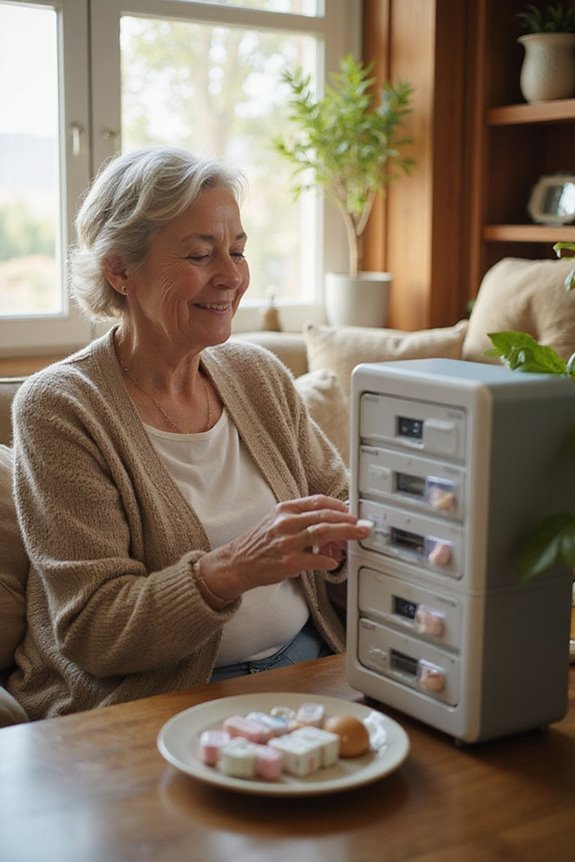To use a jar opener for arthritis effectively, choose an ergonomic design that fits comfortably in the hand. Secure the jar on a stable surface. Center the opener over the lid, applying pressure to engage the grip. Turn the handle or apply downward force if using a lever-style opener. Perform motions smoothly and steadily. These tools enhance grip, minimize strain, and facilitate independence. Further insights into selecting the right opener and optimizing use are available for exploration.
Key Takeaways
- Choose a jar opener with an ergonomic design to minimize hand strain and improve grip, making it easier to open jars.
- Position the jar on a stable surface and hold it close to your body for better control and stability while using the opener.
- For manual openers, apply a rubber or silicone grip to enhance traction and prevent slipping while turning the lid.
- Use the jar opener’s leverage features by placing it securely on the lid and applying gentle pressure to break the seal.
- If using an automatic jar opener, follow the manufacturer’s instructions for optimal functionality and minimal effort required.
Understanding Arthritis and Its Impact on Daily Tasks
Arthritis, a chronic condition affecting a significant portion of the adult population, profoundly impacts daily tasks and overall quality of life. Approximately 58.5 million adults in the U.S. live with arthritis; about 25.7 million report limitations in daily activities due to arthritis symptoms.
Key points include:
- Nearly 50% of adults with arthritis face difficulties with recreation and household chores.
- Common challenges include opening jars, writing, and grasping objects.
- The restrictions imposed by arthritis lead to increased pain, disability, and diminished quality of life.
- Psychological effects are notable, with higher rates of anxiety and depression reported among those affected.
- Many individuals benefit from using ergonomic designs that reduce hand strain and enhance ease of use.
Understanding these challenges is essential for improving life quality and addressing the needs of those living with arthritis.
Benefits of Using a Jar Opener for Arthritis
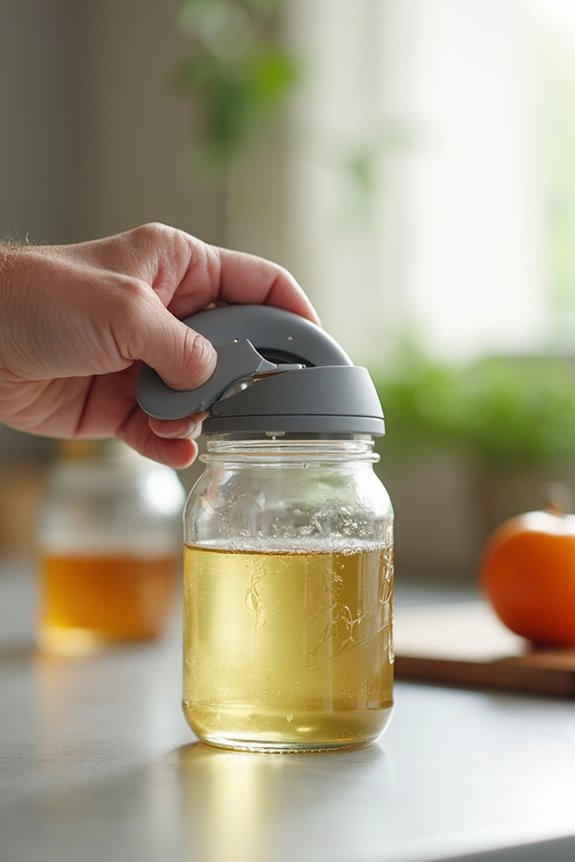
Utilizing a jar opener can greatly enhance the daily lives of individuals living with limitations in hand strength and dexterity. The benefits of these tools include:
- Reduced Hand Strain and Pain: Designed to require minimal strength, jar openers alleviate pressure on fingers and joints, preventing flare-ups.
- Improved Grip and Control: Ergonomic designs and textured surfaces enhance grip, allowing easier manipulation of lids, which fosters independence.
- Enhanced Independence in Daily Living: Users can open jars without assistance, facilitating meal preparation and preserving autonomy.
- Prevention of Injury and Further Joint Damage: These tools minimize awkward hand positions, decreasing the risk of exacerbating arthritis.
- Cost-Effective Solutions: Many models are affordable, widely available, and cater to various jar sizes. Additionally, high customer ratings reflect their effectiveness and user satisfaction.
Types of Jar Openers Suitable for Arthritis
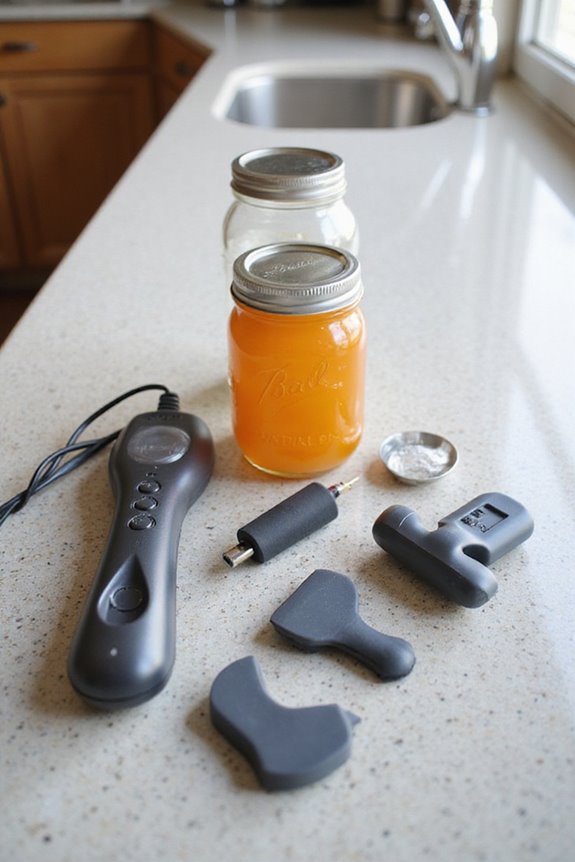
Jar openers designed for individuals with hand limitations come in various types, each catering to specific needs and preferences.
Manual Jar Openers
- Utilize rubber or silicone sheets for improved grip.
- Compact and dishwasher safe; ideal for easy storage.
- Models like Regent Jar Grips provide reliable performance.
Ergonomic Jar Openers
- Feature large rubberized handles to reduce strain.
- Suitable for those with carpal tunnel syndrome or arthritis.
- Overhand grip design accommodates medium to large jars.
Lever and Wedge-Style Jar Openers
- Use leverage to break seals without strong grip strength.
- Effective for vacuum-sealed jars, enhancing usability.
Automatic Jar Openers
- Motorized for minimal user effort, ideal for severe weakness.
- Adaptable for various jar sizes and types.
These options guarantee accessibility in the kitchen for all users.
How to Use a Jar Opener Effectively
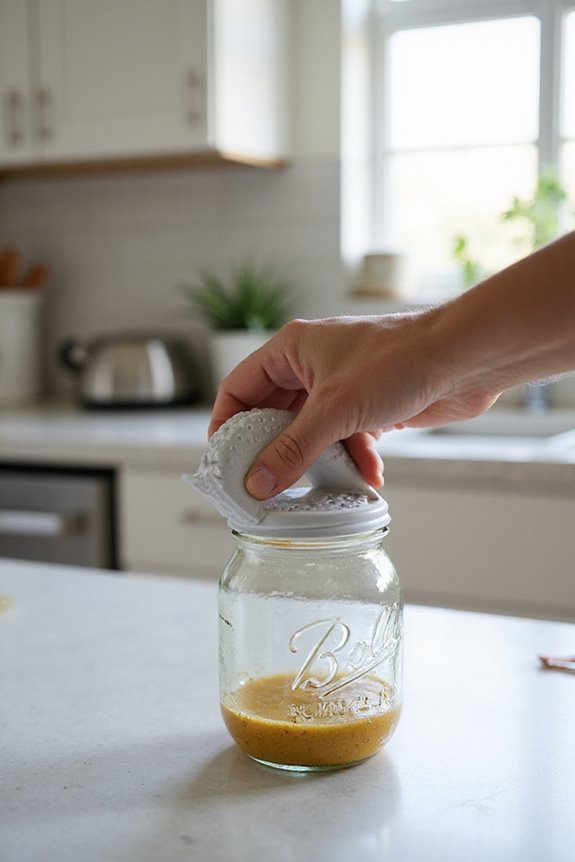
Effective use of a jar opener can greatly enhance the ability to open jars, particularly for individuals with limited hand strength. Proper preparation is essential; guarantee jars and lids are clean and dry, and warm the lid under water to ease removal. Position the jar opener’s ergonomic design evenly over the lid, adjusting it for a snug fit to maximize grip strength.
When using the opener, engage the handle slowly for controlled pressure, utilizing leverage rather than sudden force. For electric openers, allow the device to rotate the lid automatically. Regular maintenance, such as cleaning and inspecting for damage, guarantees safety and effectiveness. By following these steps, individuals can improve their independence in daily tasks while minimizing discomfort.
Features to Look for in Arthritis-Friendly Jar Openers
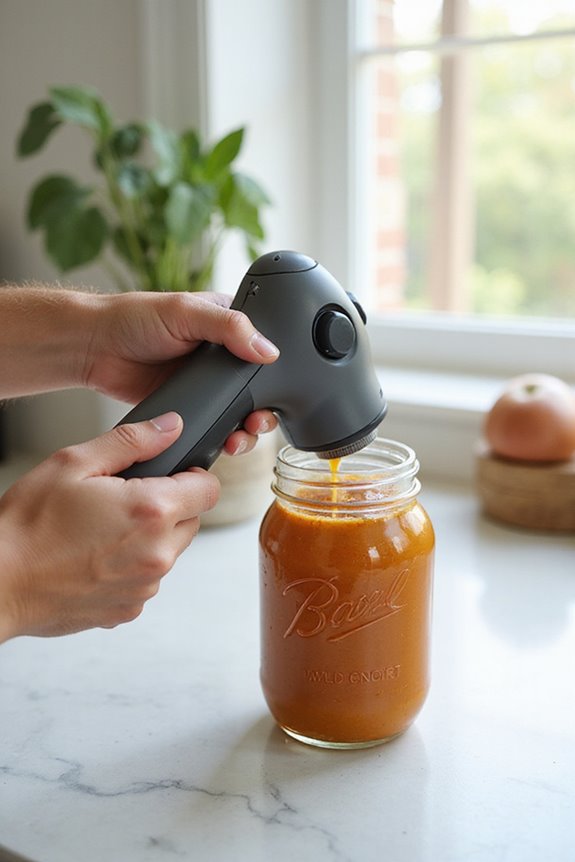
When selecting an arthritis-friendly jar opener, what features should one prioritize for ideal functionality?
Ergonomic Design
- Non-slip material reduces injury risk.
- Wide or flattened grip supports limited dexterity.
- Lightweight build minimizes hand strain.
- Cushioned surfaces enhance comfort and reduce joint pressure.
- Contoured shape improves control.
Efficient Lid Engagement and Grip
- Sharp stainless steel teeth guarantee secure lid engagement.
- Adjustable clamps accommodate various lid sizes.
- Sturdy construction maintains grip integrity.
Ease of Operation
- One-handed operation facilitates independence.
- Lever mechanisms reduce force needed.
- Minimal wrist rotation limits discomfort.
Durability
- Corrosion-resistant materials guarantee longevity.
- Easy to clean for maintenance.
These features collectively enhance usability, making the jar opener suitable for individuals with varying grip strength and arthritis.
Tips for Enhancing the Jar Opening Experience
Enhancing the jar opening experience for individuals with arthritis involves implementing various strategies and techniques that prioritize safety and efficiency.
Grip Techniques
- Use grippy materials like rubberized liners to prevent slips.
- Wrap the lid with a towel or rubber band for improved traction.
- Employ gloves to increase friction and reduce strain.
Jar Stability
- Hold the jar closer to the torso for enhanced stability.
- Experiment with one- and two-hand techniques for comfort.
- Utilize adjustable and ergonomic jar openers for superior control.
Physical Techniques
- Turn the jar counter-clockwise with the right hand and clockwise with the left to match natural movement.
- Gently tap the bottom of the jar to break the seal, ensuring careful handling to avoid injury.
Proper Maintenance of Jar Openers
Proper maintenance of jar openers is essential to guarantee their longevity and effectiveness, particularly for individuals with arthritis who rely on these tools for daily tasks.
Cleaning and Hygiene
- Clean rubber grips and jars with a dry cloth for effective gripping.
- Hand wash manual jar openers; avoid immersing electric models in water.
- Use mild detergent if necessary, rinsing thoroughly to prevent slippery residues.
Battery and Mechanical Maintenance****
- Replace batteries as instructed by the manufacturer.
- Regularly inspect moving parts for wear.
Storage
– Store in a dry place, avoiding heavy objects on top.
Inspection
- Check rubber grips and locking mechanisms for functionality.
- Replace worn parts promptly to ascertain safe operation.
Personalizing Your Jar Opener Choice
Selecting the appropriate jar opener is essential for individuals with arthritis, as it directly impacts their ability to perform daily tasks with ease and efficiency. Personalization of jar openers can greatly enhance usability.
- Custom grip options are available to cater to varying hand sizes and strength levels, ensuring comfort during use.
- Adjustable designs offer versatility in accommodating different lid sizes, increasing functionality across various jar types.
Ergonomic features, such as soft, cushioned grips and long handles, help minimize strain, providing better torque and reducing hand effort.
Incorporating tools with multiple gripping points further aids in securing jars, allowing users to open jars effectively with minimal physical exertion. Such tailored selections foster kitchen independence for those with limited hand function.
Additional Tools for Kitchen Independence
The incorporation of additional tools for kitchen independence is vital for individuals living with arthritis, as these tools can greatly alleviate the challenges faced during meal preparation.
Key Tools Include:
- Adaptive Utensils: Designed with bent or angled handles, these utensils enhance grip comfort and reduce strain.
- Ergonomic Designs: Products with larger, cushioned handles improve handling, minimizing joint stress.
- Electric Jar Openers: Automate lid removal, lessening hand and wrist strain.
- Automatic Can Openers: Eliminate twisting motions that can aggravate symptoms.
- Non-Slip Mats: Stabilize cutting boards, reducing the need for excessive pressure.
Research indicates that approximately 60% of individuals with arthritis utilize such aids, with 95% reporting improved quality of life and 79% maintaining their independence. Access to these tools is significant for effective kitchen functioning, as adaptive utensils are specifically designed to enhance mealtime independence for users with limited dexterity.
Resources for Hand Health and Strengthening
Hand health and strengthening represent crucial components in managing arthritis effectively. Engaging in structured exercise programs yields considerable exercise benefits, including enhanced hand mobility and grip strength.
Key Resources:
- Healthcare Professionals: Tailored exercise programs can be developed with their guidance.
- Online Tutorials: Accessible videos facilitate home practice of specific exercises.
- Support Groups: Community support fosters motivation and shared experiences.
- Publications: Research articles provide evidence-based insights on effective hand exercises.
Exercise Focus:
- Short-Term Outcomes: Improved pain, function, and stiffness noted in exercise participants.
- Long-Term Considerations: Consistency is essential for sustained benefits; however, evidence on long-term effects remains limited. Incorporating ergonomic designs into daily activities can also significantly improve hand function and reduce strain.
Utilizing these resources can greatly enhance hand health and overall quality of life for individuals with arthritis.
Frequently Asked Questions
Can Jar Openers Be Used by Individuals Without Arthritis?
Jar openers benefit all users, not just those with arthritis. Their user-friendly designs enhance grip strength, reduce effort, and improve safety, making kitchen tasks easier and quicker for everyone, regardless of hand strength or dexterity.
Are Jar Openers Dishwasher Safe for Easy Cleaning?
Regarding jar openers, many models are made from dishwasher-safe materials, offering convenience. Cleaning tips suggest using warm soapy water for non-dishwasher safe options, ensuring longevity and ideal performance for all users in their culinary endeavors.
How Do I Choose the Right Size Jar Opener?
In a kitchen filled with jars, choosing the right size jar opener involves exploring various jar opener types and features. Adjustable grips and ergonomic designs enhance comfort, ensuring users find the perfect fit for their needs.
Can Jar Openers Help With Other Kitchen Tasks?
Jar openers serve as versatile kitchen gadget alternatives, enhancing various tasks. These ergonomic kitchen tools not only open jars but also assist with bottles and cans, fostering independence and ease in meal preparation for everyone.
Where Can I Find Jar Openers Specifically Designed for Seniors?
Seniors seeking jar openers can explore online retailers specializing in senior products. These platforms offer a wide variety of adaptive tools, ensuring accessibility and convenience for those looking to enhance their kitchen experience.




